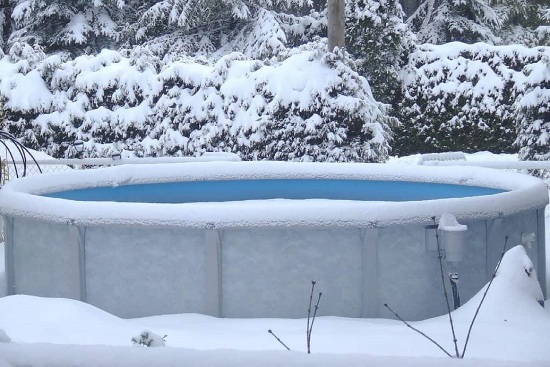An above ground pool needs maintenance all year though it provides great fun in your backyard. It requires special care during winter months to ensure it stays in good condition and to avoid hefty bills for its cleaning once the snow melts away.
The preparation for pool winterisation should start well before the winter season begins. Fortunately, hiring a professional for above ground pool maintenance in winter might be unnecessary.


How to Winterise an Above Ground Pool
An above ground pool is an investment that you should protect with appropriate maintenance through the seasons. These pools require special care in winter if you’d like them to serve you for many years. The following steps will guide you on how to go about the maintenance process during winter.
1. Water pH checking and balancing
PH levels should be checked at least two weeks before the pool’s closing. The chlorine/bromine readings should range between 1.0-3.0 ppm in the final test before closing. Water becomes corrosive as temperatures drop, hence the need for balanced chemical levels.
This corrosive water eventually corrodes the metal parts of the pool, such as the screws; stains the pool surface, and makes the pool liner brittle, which leads to its tearing.
2. Vacuum the pool
The pool needs thorough physical cleaning before closing it. Since it will be out of use for months, the pool floor, wall, and backwash filter should get a thorough cleanup. A final backwash should complete the cleaning to ensure vacuuming all the minerals, filter sand, and organic deposits out of the pool.
After that, reduce the water level in the pool to at least 4 inches below the skimmer’s mouth. Inspect the pool structure to see if the steel components have scratches since the exposed area will rust over time. Cover any scratched sections with protective paint to protect those steel components so they do not weaken the pool structure.
3. Preparing the equipment for winter
Switch off the power before starting this step. The procedure involves removing the pump and filter if it is detachable. Unplugging the pump and storing it upside down until all the water drains out prepares it for storage in an indoor shelter.
The pool winterising can proceed with any fixed parts that cannot be detached. That is why it is important to carefully balance the water alkalinity and use the appropriate choice and levels of winterising chemicals – it will ensure the equipment does not suffer damage like corrosion while in the pool during winter.
If the pool has a heater, it should be turned off and cleaned out following the directions in the manual. The heater usually runs on gas, so the operation could be risky if one is not well-versed in such operations.
Consulting an expert is wise to avert accidents or damages from oversights due to a lack of winterisation skills. The above ground pool liners are the pipes and hoses – winterisation involves disconnecting them and storing them safely.
4. Installing the above ground winter pool cover
The pool cover, made of a poly-woven material, withstands harsh weather. Besides the above preparatory steps, confirm that the pool has no leaks before placing this cover. Despite the cover’s durability, it should stay clear of abrasive or protruding corners and points.
Before placing the pool cover, the water should be clean without leaves and other debris. When installing it, the pool cover should rest upon the lowered water surface and rise to cover the pool edges all around while puckering it to keep it straightened. A cable is attached to hold the cover in place, especially in winter winds.
Depending on the location of the pool, if it is at a place where leaves and other debris could fall on the pool cover, their weight will eventually damage the pool cover. A leaf cover is installed above the winter cover to collect such debris and protect the winter pool cover.
Since the leaf cover rests right above the winter cover, consider removing it when the freezing weather starts to reduce the weight on the pool cover. As the winter months progress and the winds keep blowing the winter cover, the use of wall bags keeps the cover in place until it’s time to open the pool and enjoy it again.
Final Thoughts
Preparing and setting up an above ground pool should become an annual practice to enhance the pool’s durability. Though it seems complicated, with time and practice, it becomes a breeze. However, experts exist for consultation on the best winterisation procedures to avoid damaging your pool.
























